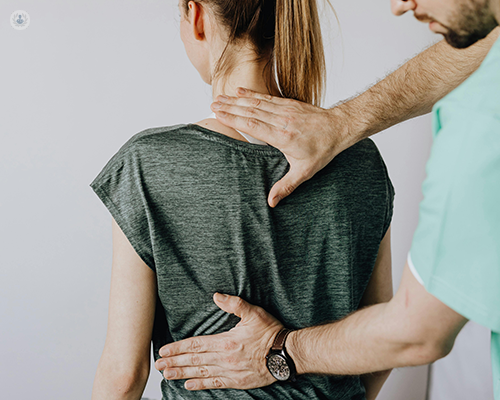How to spot and treat scoliosis
Escrito por:Scoliosis is a condition that can affect people of all ages, though it’s most commonly diagnosed in children and adolescents during their growth spurts.
Mr Rohit Shetty, renowned consultant orthopaedic and spinal surgeon, offers an expert insight into scoliosis, answering key questions about its causes, symptoms, and treatment options.

What is scoliosis?
Scoliosis is a condition where the spine curves sideways, creating either an "S" or "C" shape. The curvature can occur in different parts of the spine, typically in the thoracic (mid-back) or lumbar (lower back) regions.
There are several types of scoliosis, including:
- Idiopathic scoliosis: This is the most common type, with no known cause. It’s more prevalent in girls than boys.
- Congenital scoliosis: This is caused by abnormal spinal development in the womb, resulting in a sideways curvature of the spine present at birth.
- Neuromuscular scoliosis: This is associated with conditions such as cerebral palsy, muscular dystrophy, or spinal cord injuries, which affect the muscles and nerves that support the spine.
What are the signs of scoliosis?
The main sign of scoliosis is an abnormal lateral curvature of the spine.
Other signs include:
- one shoulder being higher than the other
- one shoulder blade protruding out more than the other
- having an asymmetrical waist
- one hip appearing higher than the other
- back pain or discomfort
Parents should be vigilant for these signs, especially during a child's growth spurts. Early detection and intervention can prevent the curvature from worsening.
Does scoliosis run in families?
Yes, scoliosis can run in families. Clinical research indicates a genetic component to idiopathic scoliosis, suggesting that a family history of the condition increases the likelihood of developing it. If a parent or sibling has scoliosis, it’s important to monitor children closely for any signs of spinal curvature, particularly during their growth spurts.
How is scoliosis diagnosed?
The process of diagnosing scoliosis involves a specialist conducting a physical examination to assess the curvature of the spine. Common methods used in this examination include the Adam Forward Bend Test, where you bend forward at the waist, allowing the specialist to observe the spine for any abnormal curvature or asymmetry. Another method is the use of a scoliometer, a device that measures the angle of trunk rotation, providing an initial assessment of the spinal curve.
If scoliosis is suspected, imaging tests are then performed to confirm the diagnosis and assess the severity of the curvature. X-rays are the primary tool for diagnosing scoliosis, as they provide clear images of the spine and help measure the degree of curvature. In some cases, an MRI may be ordered to evaluate the spinal cord and detect any underlying conditions. A CT scan, although used less frequently, can provide detailed images of the spine and surrounding structures.
What treatment options are available for scoliosis?
Treatment for scoliosis depends on the type, severity of the curve, and the age of the patient. Options include:
Observation
For mild cases of scoliosis, particularly in children and adolescents who are still growing, observation may be the recommended course of action. Regular check-ups and X-rays are used to monitor the curvature for any signs of progression.
Bracing
Bracing is often used for moderate scoliosis in growing children and adolescents. While braces don’t cure scoliosis or reverse the curve, they can prevent further progression. Bracing is most effective when worn for the prescribed number of hours each day, typically ranging from 16 to 23 hours.
Physical therapy
Physical therapy can help manage symptoms of scoliosis, improve posture, and strengthen the muscles supporting the spine. While it can’t correct the curvature, targeted exercises can enhance overall spinal health and reduce discomfort.
When is surgery necessary for scoliosis?
Spinal surgery is typically considered for severe cases of scoliosis where the curvature exceeds 40-50 degrees and continues to progress despite non-surgical treatments. The primary goals of surgery are to correct the spinal curvature as much as possible, stabilise the spine, and prevent further progression.
Several surgical options are available, including:
- Spinal fusion: This is the most common surgical procedure for scoliosis. During spinal fusion, the surgeon connects two or more vertebrae using bone grafts, rods, and screws to stabilise and straighten the spine.
- Growing rods: This is recommended for young children with severe scoliosis as growing rods can be lengthened periodically to accommodate the child's growth, reducing the need for multiple surgeries.
- Vertebral body tethering (VBT): This is a less invasive procedure that involves placing a flexible cord along the spine. The tension of the cord assists in aligning the spine while accommodating growth. VBT is often recommended for children and adolescents who are still growing.
If you or your child exhibits signs of scoliosis, it’s important to seek medical attention for a thorough evaluation and personalised treatment plan.
If you would like to schedule an appointment with Mr Rohit Shetty, head on over to his Top Doctors profile today.


